7414MED - Health Project Proposal Critique & Evaluation Report
VerifiedAdded on 2023/06/04
|9
|2362
|363
Report
AI Summary
This document presents a critique and evaluation report of two project proposals submitted to Griffith UniBank for health improvement initiatives. The report assesses each proposal ('Country X' and 'Country Y') based on criteria such as background relevance, project objectives, implementation arrangements, budget, monitoring and evaluation plans, and risk assessment. Each section of the proposals is scored and justified, leading to a recommendation on whether to fund, reconsider, or reject each project. The critique highlights the strengths and weaknesses of each proposal, considering factors like clarity of objectives, sustainability, stakeholder engagement, and financial management. The final recommendation emphasizes the importance of ensuring long-term project impact and financial sustainability for the recipient countries. Desklib provides access to similar project evaluations and related study resources.
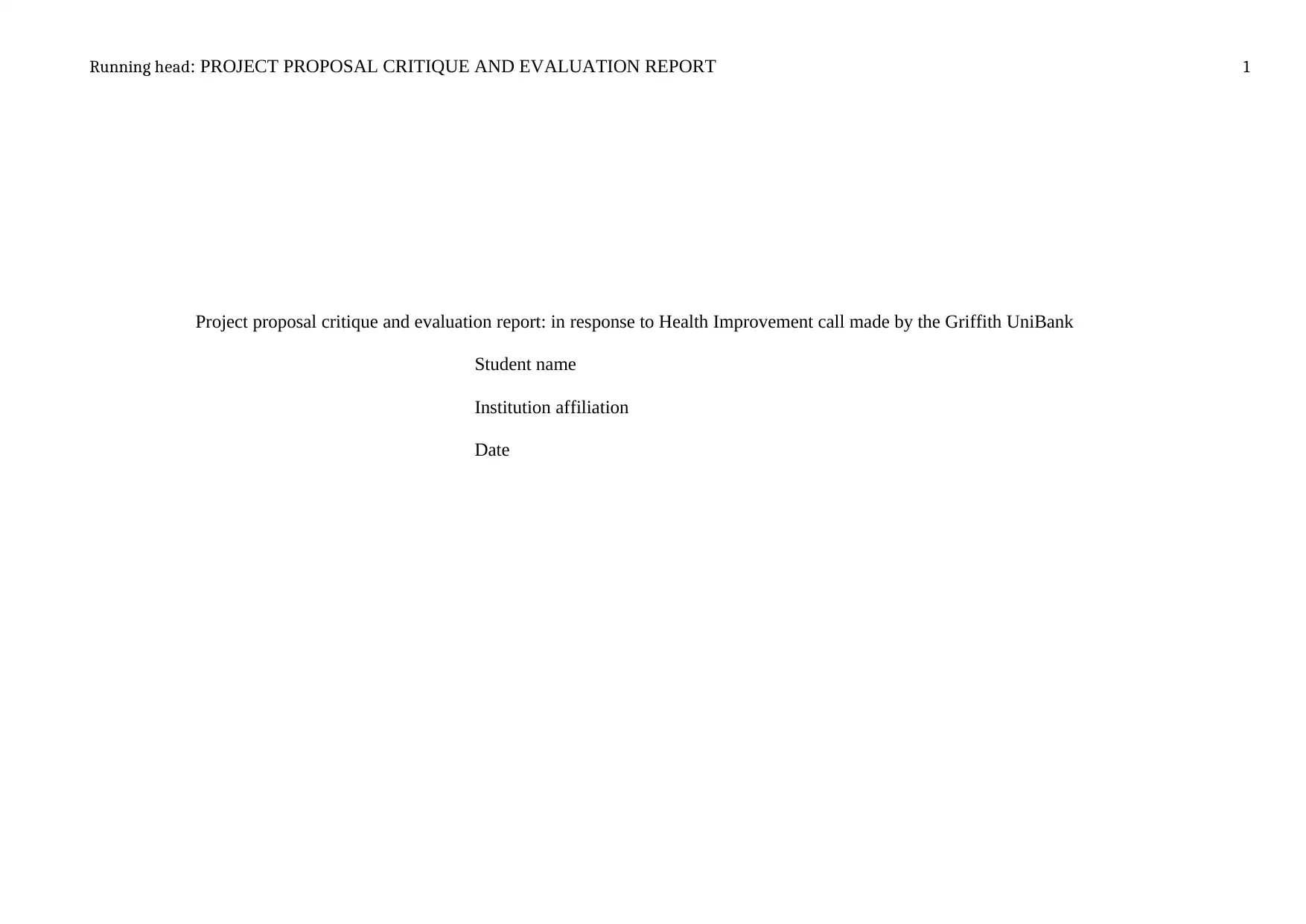
Running head: PROJECT PROPOSAL CRITIQUE AND EVALUATION REPORT 1
Project proposal critique and evaluation report: in response to Health Improvement call made by the Griffith UniBank
Student name
Institution affiliation
Date
Project proposal critique and evaluation report: in response to Health Improvement call made by the Griffith UniBank
Student name
Institution affiliation
Date
Paraphrase This Document
Need a fresh take? Get an instant paraphrase of this document with our AI Paraphraser
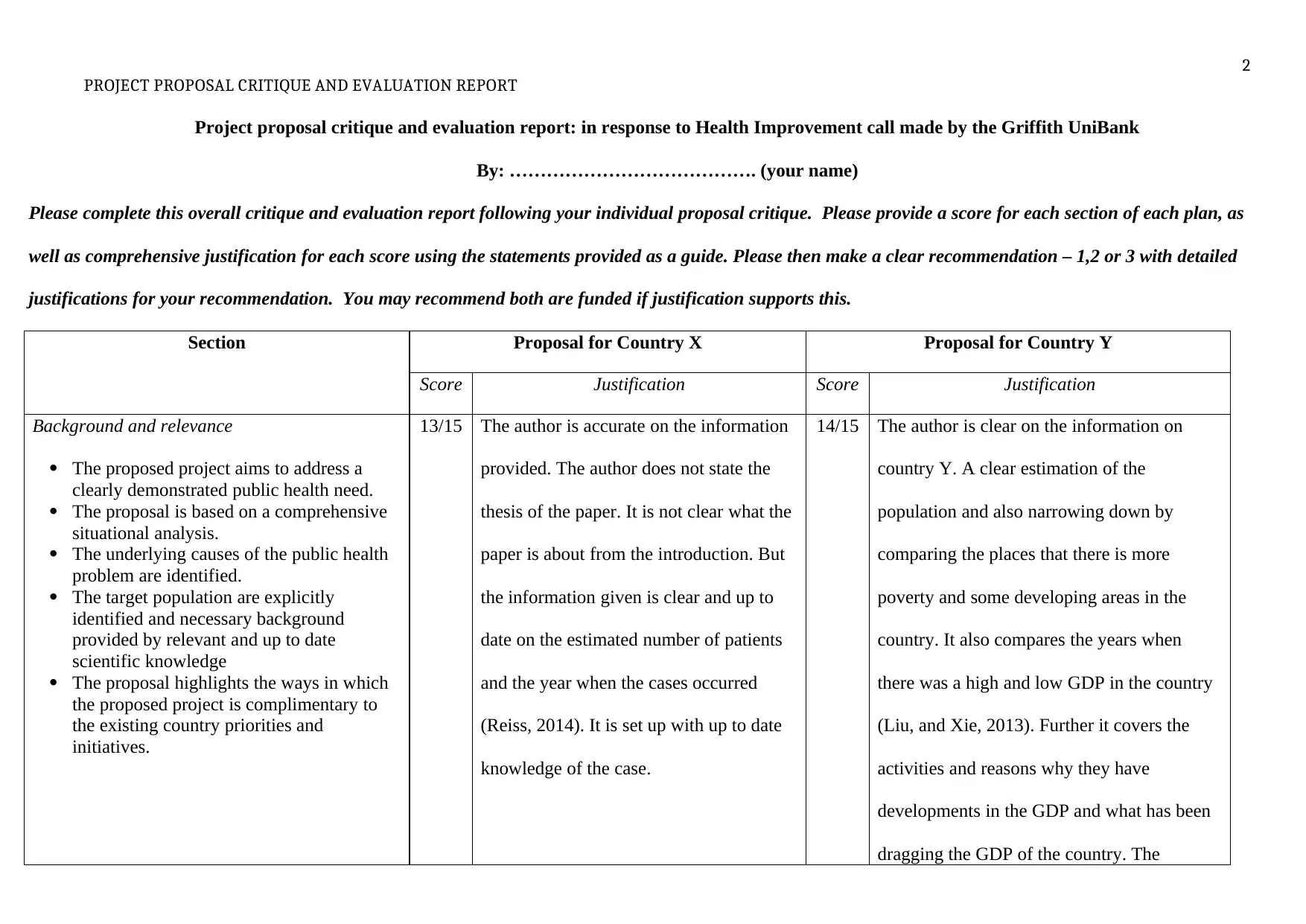
2
PROJECT PROPOSAL CRITIQUE AND EVALUATION REPORT
Project proposal critique and evaluation report: in response to Health Improvement call made by the Griffith UniBank
By: …………………………………. (your name)
Please complete this overall critique and evaluation report following your individual proposal critique. Please provide a score for each section of each plan, as
well as comprehensive justification for each score using the statements provided as a guide. Please then make a clear recommendation – 1,2 or 3 with detailed
justifications for your recommendation. You may recommend both are funded if justification supports this.
Section Proposal for Country X Proposal for Country Y
Score Justification Score Justification
Background and relevance
The proposed project aims to address a
clearly demonstrated public health need.
The proposal is based on a comprehensive
situational analysis.
The underlying causes of the public health
problem are identified.
The target population are explicitly
identified and necessary background
provided by relevant and up to date
scientific knowledge
The proposal highlights the ways in which
the proposed project is complimentary to
the existing country priorities and
initiatives.
13/15 The author is accurate on the information
provided. The author does not state the
thesis of the paper. It is not clear what the
paper is about from the introduction. But
the information given is clear and up to
date on the estimated number of patients
and the year when the cases occurred
(Reiss, 2014). It is set up with up to date
knowledge of the case.
14/15 The author is clear on the information on
country Y. A clear estimation of the
population and also narrowing down by
comparing the places that there is more
poverty and some developing areas in the
country. It also compares the years when
there was a high and low GDP in the country
(Liu, and Xie, 2013). Further it covers the
activities and reasons why they have
developments in the GDP and what has been
dragging the GDP of the country. The
PROJECT PROPOSAL CRITIQUE AND EVALUATION REPORT
Project proposal critique and evaluation report: in response to Health Improvement call made by the Griffith UniBank
By: …………………………………. (your name)
Please complete this overall critique and evaluation report following your individual proposal critique. Please provide a score for each section of each plan, as
well as comprehensive justification for each score using the statements provided as a guide. Please then make a clear recommendation – 1,2 or 3 with detailed
justifications for your recommendation. You may recommend both are funded if justification supports this.
Section Proposal for Country X Proposal for Country Y
Score Justification Score Justification
Background and relevance
The proposed project aims to address a
clearly demonstrated public health need.
The proposal is based on a comprehensive
situational analysis.
The underlying causes of the public health
problem are identified.
The target population are explicitly
identified and necessary background
provided by relevant and up to date
scientific knowledge
The proposal highlights the ways in which
the proposed project is complimentary to
the existing country priorities and
initiatives.
13/15 The author is accurate on the information
provided. The author does not state the
thesis of the paper. It is not clear what the
paper is about from the introduction. But
the information given is clear and up to
date on the estimated number of patients
and the year when the cases occurred
(Reiss, 2014). It is set up with up to date
knowledge of the case.
14/15 The author is clear on the information on
country Y. A clear estimation of the
population and also narrowing down by
comparing the places that there is more
poverty and some developing areas in the
country. It also compares the years when
there was a high and low GDP in the country
(Liu, and Xie, 2013). Further it covers the
activities and reasons why they have
developments in the GDP and what has been
dragging the GDP of the country. The
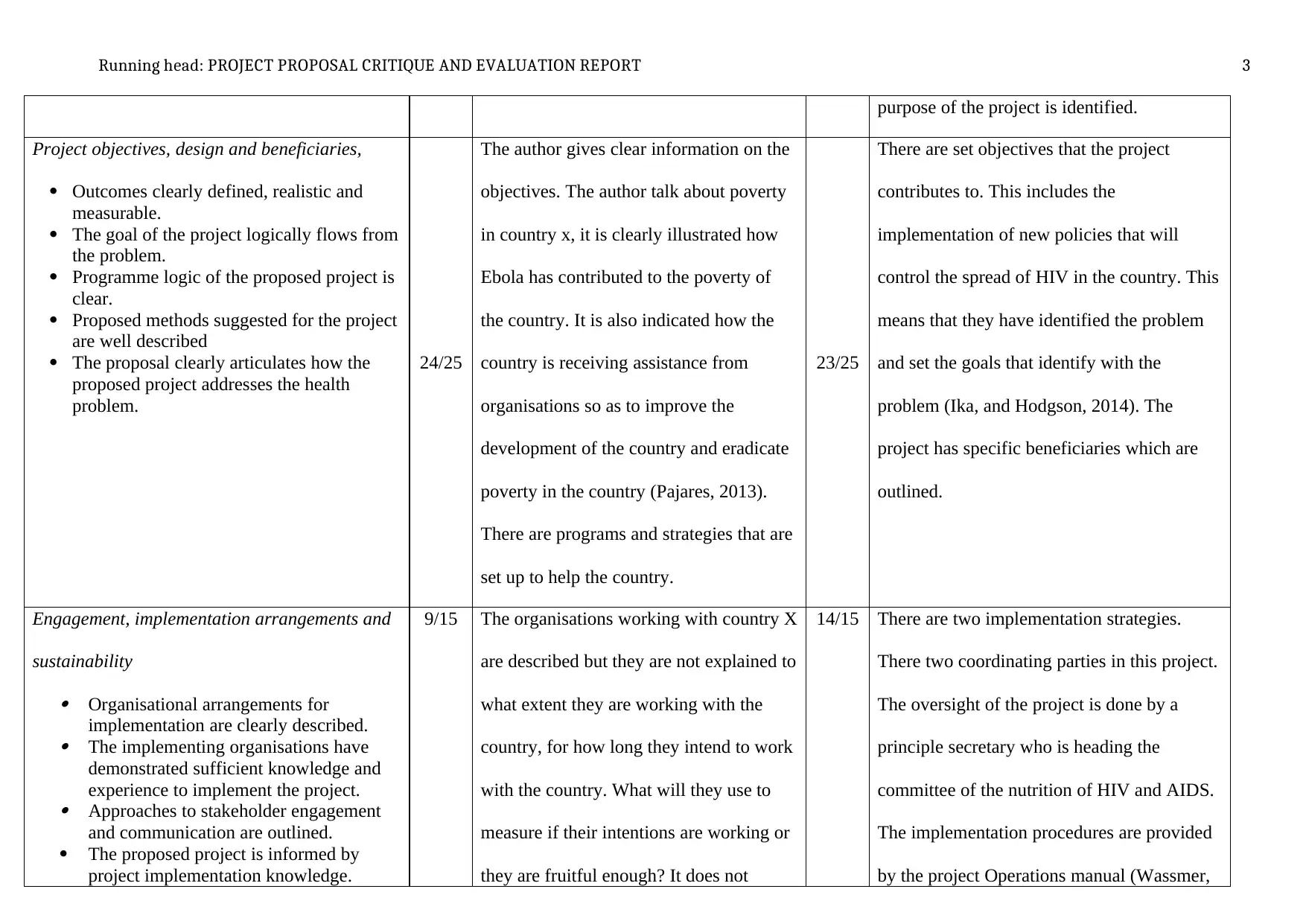
Running head: PROJECT PROPOSAL CRITIQUE AND EVALUATION REPORT 3
purpose of the project is identified.
Project objectives, design and beneficiaries,
Outcomes clearly defined, realistic and
measurable.
The goal of the project logically flows from
the problem.
Programme logic of the proposed project is
clear.
Proposed methods suggested for the project
are well described
The proposal clearly articulates how the
proposed project addresses the health
problem.
24/25
The author gives clear information on the
objectives. The author talk about poverty
in country x, it is clearly illustrated how
Ebola has contributed to the poverty of
the country. It is also indicated how the
country is receiving assistance from
organisations so as to improve the
development of the country and eradicate
poverty in the country (Pajares, 2013).
There are programs and strategies that are
set up to help the country.
23/25
There are set objectives that the project
contributes to. This includes the
implementation of new policies that will
control the spread of HIV in the country. This
means that they have identified the problem
and set the goals that identify with the
problem (Ika, and Hodgson, 2014). The
project has specific beneficiaries which are
outlined.
Engagement, implementation arrangements and
sustainability
Organisational arrangements for
implementation are clearly described. The implementing organisations have
demonstrated sufficient knowledge and
experience to implement the project. Approaches to stakeholder engagement
and communication are outlined.
The proposed project is informed by
project implementation knowledge.
9/15 The organisations working with country X
are described but they are not explained to
what extent they are working with the
country, for how long they intend to work
with the country. What will they use to
measure if their intentions are working or
they are fruitful enough? It does not
14/15 There are two implementation strategies.
There two coordinating parties in this project.
The oversight of the project is done by a
principle secretary who is heading the
committee of the nutrition of HIV and AIDS.
The implementation procedures are provided
by the project Operations manual (Wassmer,
purpose of the project is identified.
Project objectives, design and beneficiaries,
Outcomes clearly defined, realistic and
measurable.
The goal of the project logically flows from
the problem.
Programme logic of the proposed project is
clear.
Proposed methods suggested for the project
are well described
The proposal clearly articulates how the
proposed project addresses the health
problem.
24/25
The author gives clear information on the
objectives. The author talk about poverty
in country x, it is clearly illustrated how
Ebola has contributed to the poverty of
the country. It is also indicated how the
country is receiving assistance from
organisations so as to improve the
development of the country and eradicate
poverty in the country (Pajares, 2013).
There are programs and strategies that are
set up to help the country.
23/25
There are set objectives that the project
contributes to. This includes the
implementation of new policies that will
control the spread of HIV in the country. This
means that they have identified the problem
and set the goals that identify with the
problem (Ika, and Hodgson, 2014). The
project has specific beneficiaries which are
outlined.
Engagement, implementation arrangements and
sustainability
Organisational arrangements for
implementation are clearly described. The implementing organisations have
demonstrated sufficient knowledge and
experience to implement the project. Approaches to stakeholder engagement
and communication are outlined.
The proposed project is informed by
project implementation knowledge.
9/15 The organisations working with country X
are described but they are not explained to
what extent they are working with the
country, for how long they intend to work
with the country. What will they use to
measure if their intentions are working or
they are fruitful enough? It does not
14/15 There are two implementation strategies.
There two coordinating parties in this project.
The oversight of the project is done by a
principle secretary who is heading the
committee of the nutrition of HIV and AIDS.
The implementation procedures are provided
by the project Operations manual (Wassmer,
⊘ This is a preview!⊘
Do you want full access?
Subscribe today to unlock all pages.

Trusted by 1+ million students worldwide
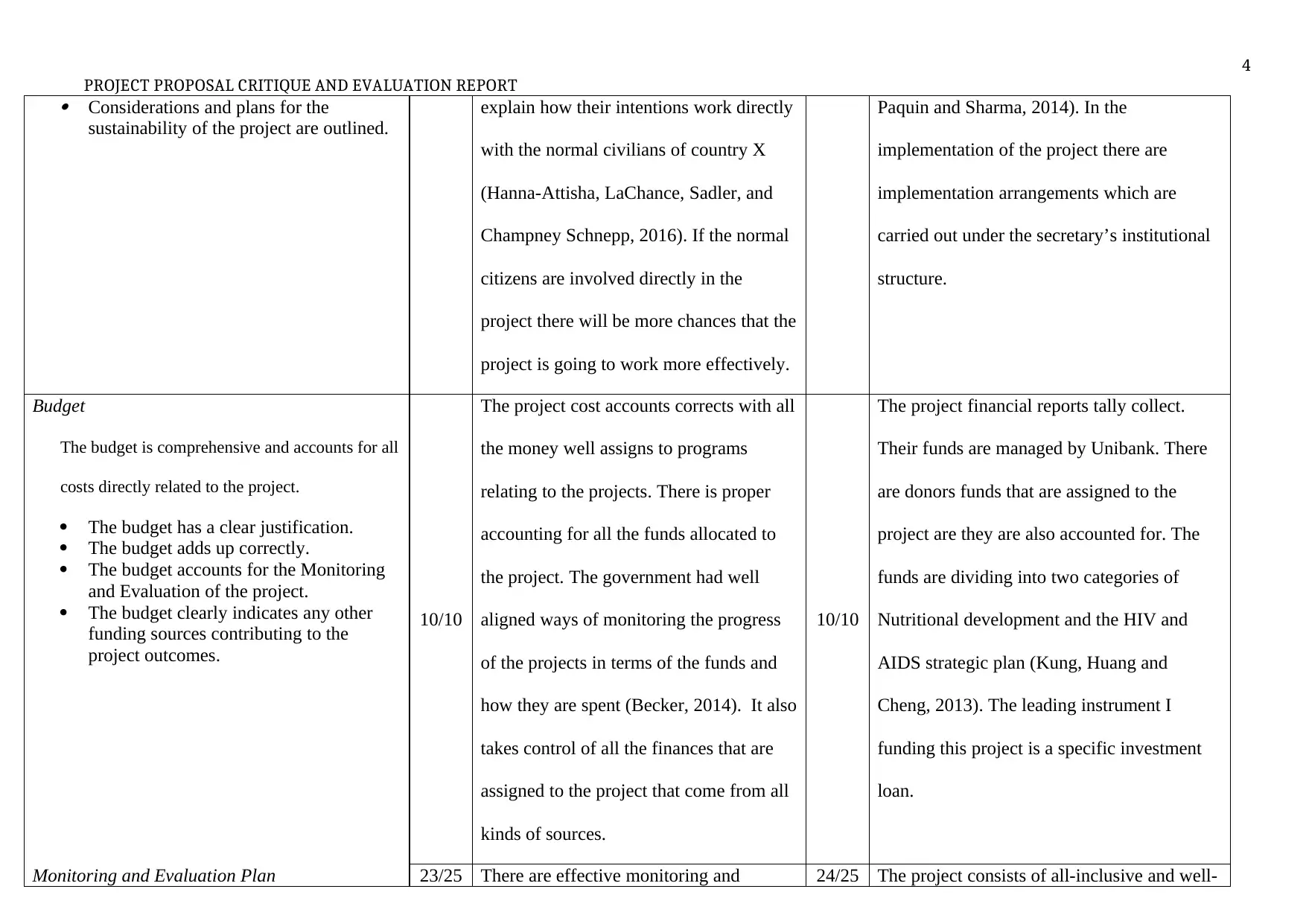
4
PROJECT PROPOSAL CRITIQUE AND EVALUATION REPORT Considerations and plans for the
sustainability of the project are outlined.
explain how their intentions work directly
with the normal civilians of country X
(Hanna-Attisha, LaChance, Sadler, and
Champney Schnepp, 2016). If the normal
citizens are involved directly in the
project there will be more chances that the
project is going to work more effectively.
Paquin and Sharma, 2014). In the
implementation of the project there are
implementation arrangements which are
carried out under the secretary’s institutional
structure.
Budget
The budget is comprehensive and accounts for all
costs directly related to the project.
The budget has a clear justification.
The budget adds up correctly.
The budget accounts for the Monitoring
and Evaluation of the project.
The budget clearly indicates any other
funding sources contributing to the
project outcomes.
10/10
The project cost accounts corrects with all
the money well assigns to programs
relating to the projects. There is proper
accounting for all the funds allocated to
the project. The government had well
aligned ways of monitoring the progress
of the projects in terms of the funds and
how they are spent (Becker, 2014). It also
takes control of all the finances that are
assigned to the project that come from all
kinds of sources.
10/10
The project financial reports tally collect.
Their funds are managed by Unibank. There
are donors funds that are assigned to the
project are they are also accounted for. The
funds are dividing into two categories of
Nutritional development and the HIV and
AIDS strategic plan (Kung, Huang and
Cheng, 2013). The leading instrument I
funding this project is a specific investment
loan.
Monitoring and Evaluation Plan 23/25 There are effective monitoring and 24/25 The project consists of all-inclusive and well-
PROJECT PROPOSAL CRITIQUE AND EVALUATION REPORT Considerations and plans for the
sustainability of the project are outlined.
explain how their intentions work directly
with the normal civilians of country X
(Hanna-Attisha, LaChance, Sadler, and
Champney Schnepp, 2016). If the normal
citizens are involved directly in the
project there will be more chances that the
project is going to work more effectively.
Paquin and Sharma, 2014). In the
implementation of the project there are
implementation arrangements which are
carried out under the secretary’s institutional
structure.
Budget
The budget is comprehensive and accounts for all
costs directly related to the project.
The budget has a clear justification.
The budget adds up correctly.
The budget accounts for the Monitoring
and Evaluation of the project.
The budget clearly indicates any other
funding sources contributing to the
project outcomes.
10/10
The project cost accounts corrects with all
the money well assigns to programs
relating to the projects. There is proper
accounting for all the funds allocated to
the project. The government had well
aligned ways of monitoring the progress
of the projects in terms of the funds and
how they are spent (Becker, 2014). It also
takes control of all the finances that are
assigned to the project that come from all
kinds of sources.
10/10
The project financial reports tally collect.
Their funds are managed by Unibank. There
are donors funds that are assigned to the
project are they are also accounted for. The
funds are dividing into two categories of
Nutritional development and the HIV and
AIDS strategic plan (Kung, Huang and
Cheng, 2013). The leading instrument I
funding this project is a specific investment
loan.
Monitoring and Evaluation Plan 23/25 There are effective monitoring and 24/25 The project consists of all-inclusive and well-
Paraphrase This Document
Need a fresh take? Get an instant paraphrase of this document with our AI Paraphraser
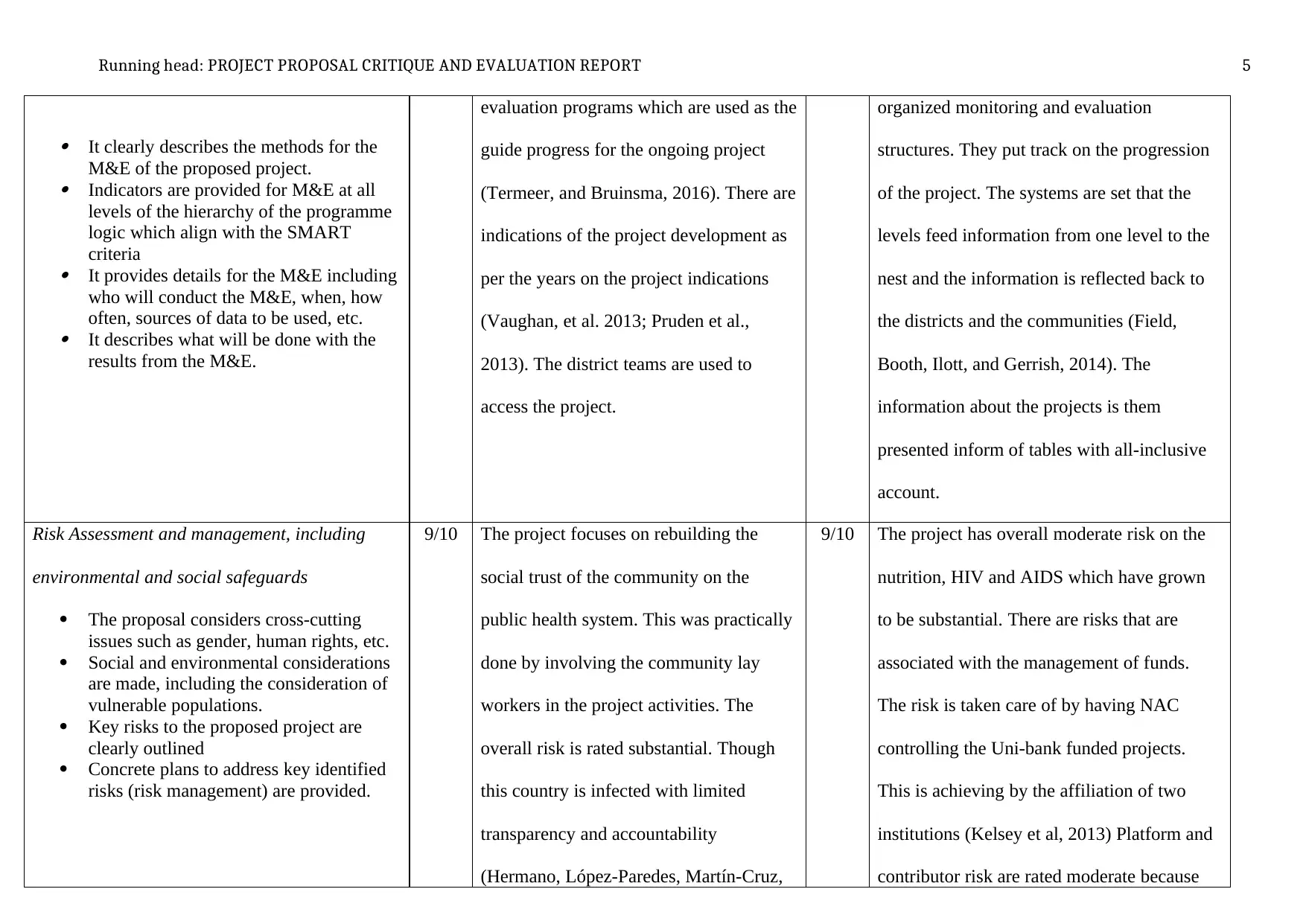
Running head: PROJECT PROPOSAL CRITIQUE AND EVALUATION REPORT 5
It clearly describes the methods for the
M&E of the proposed project. Indicators are provided for M&E at all
levels of the hierarchy of the programme
logic which align with the SMART
criteria It provides details for the M&E including
who will conduct the M&E, when, how
often, sources of data to be used, etc. It describes what will be done with the
results from the M&E.
evaluation programs which are used as the
guide progress for the ongoing project
(Termeer, and Bruinsma, 2016). There are
indications of the project development as
per the years on the project indications
(Vaughan, et al. 2013; Pruden et al.,
2013). The district teams are used to
access the project.
organized monitoring and evaluation
structures. They put track on the progression
of the project. The systems are set that the
levels feed information from one level to the
nest and the information is reflected back to
the districts and the communities (Field,
Booth, Ilott, and Gerrish, 2014). The
information about the projects is them
presented inform of tables with all-inclusive
account.
Risk Assessment and management, including
environmental and social safeguards
The proposal considers cross-cutting
issues such as gender, human rights, etc.
Social and environmental considerations
are made, including the consideration of
vulnerable populations.
Key risks to the proposed project are
clearly outlined
Concrete plans to address key identified
risks (risk management) are provided.
9/10 The project focuses on rebuilding the
social trust of the community on the
public health system. This was practically
done by involving the community lay
workers in the project activities. The
overall risk is rated substantial. Though
this country is infected with limited
transparency and accountability
(Hermano, López-Paredes, Martín-Cruz,
9/10 The project has overall moderate risk on the
nutrition, HIV and AIDS which have grown
to be substantial. There are risks that are
associated with the management of funds.
The risk is taken care of by having NAC
controlling the Uni-bank funded projects.
This is achieving by the affiliation of two
institutions (Kelsey et al, 2013) Platform and
contributor risk are rated moderate because
It clearly describes the methods for the
M&E of the proposed project. Indicators are provided for M&E at all
levels of the hierarchy of the programme
logic which align with the SMART
criteria It provides details for the M&E including
who will conduct the M&E, when, how
often, sources of data to be used, etc. It describes what will be done with the
results from the M&E.
evaluation programs which are used as the
guide progress for the ongoing project
(Termeer, and Bruinsma, 2016). There are
indications of the project development as
per the years on the project indications
(Vaughan, et al. 2013; Pruden et al.,
2013). The district teams are used to
access the project.
organized monitoring and evaluation
structures. They put track on the progression
of the project. The systems are set that the
levels feed information from one level to the
nest and the information is reflected back to
the districts and the communities (Field,
Booth, Ilott, and Gerrish, 2014). The
information about the projects is them
presented inform of tables with all-inclusive
account.
Risk Assessment and management, including
environmental and social safeguards
The proposal considers cross-cutting
issues such as gender, human rights, etc.
Social and environmental considerations
are made, including the consideration of
vulnerable populations.
Key risks to the proposed project are
clearly outlined
Concrete plans to address key identified
risks (risk management) are provided.
9/10 The project focuses on rebuilding the
social trust of the community on the
public health system. This was practically
done by involving the community lay
workers in the project activities. The
overall risk is rated substantial. Though
this country is infected with limited
transparency and accountability
(Hermano, López-Paredes, Martín-Cruz,
9/10 The project has overall moderate risk on the
nutrition, HIV and AIDS which have grown
to be substantial. There are risks that are
associated with the management of funds.
The risk is taken care of by having NAC
controlling the Uni-bank funded projects.
This is achieving by the affiliation of two
institutions (Kelsey et al, 2013) Platform and
contributor risk are rated moderate because
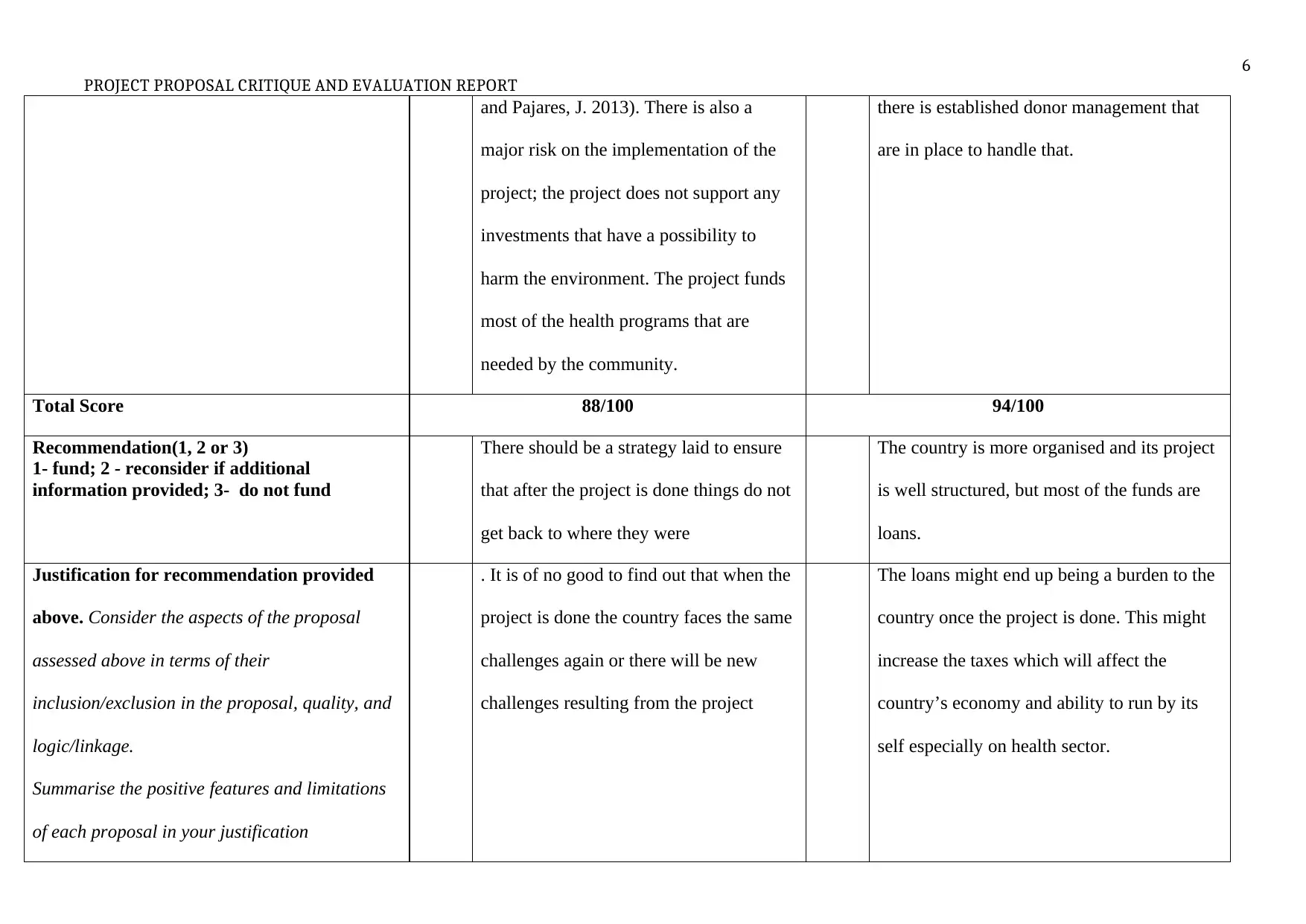
6
PROJECT PROPOSAL CRITIQUE AND EVALUATION REPORT
and Pajares, J. 2013). There is also a
major risk on the implementation of the
project; the project does not support any
investments that have a possibility to
harm the environment. The project funds
most of the health programs that are
needed by the community.
there is established donor management that
are in place to handle that.
Total Score 88/100 94/100
Recommendation(1, 2 or 3)
1- fund; 2 - reconsider if additional
information provided; 3- do not fund
There should be a strategy laid to ensure
that after the project is done things do not
get back to where they were
The country is more organised and its project
is well structured, but most of the funds are
loans.
Justification for recommendation provided
above. Consider the aspects of the proposal
assessed above in terms of their
inclusion/exclusion in the proposal, quality, and
logic/linkage.
Summarise the positive features and limitations
of each proposal in your justification
. It is of no good to find out that when the
project is done the country faces the same
challenges again or there will be new
challenges resulting from the project
The loans might end up being a burden to the
country once the project is done. This might
increase the taxes which will affect the
country’s economy and ability to run by its
self especially on health sector.
PROJECT PROPOSAL CRITIQUE AND EVALUATION REPORT
and Pajares, J. 2013). There is also a
major risk on the implementation of the
project; the project does not support any
investments that have a possibility to
harm the environment. The project funds
most of the health programs that are
needed by the community.
there is established donor management that
are in place to handle that.
Total Score 88/100 94/100
Recommendation(1, 2 or 3)
1- fund; 2 - reconsider if additional
information provided; 3- do not fund
There should be a strategy laid to ensure
that after the project is done things do not
get back to where they were
The country is more organised and its project
is well structured, but most of the funds are
loans.
Justification for recommendation provided
above. Consider the aspects of the proposal
assessed above in terms of their
inclusion/exclusion in the proposal, quality, and
logic/linkage.
Summarise the positive features and limitations
of each proposal in your justification
. It is of no good to find out that when the
project is done the country faces the same
challenges again or there will be new
challenges resulting from the project
The loans might end up being a burden to the
country once the project is done. This might
increase the taxes which will affect the
country’s economy and ability to run by its
self especially on health sector.
⊘ This is a preview!⊘
Do you want full access?
Subscribe today to unlock all pages.

Trusted by 1+ million students worldwide
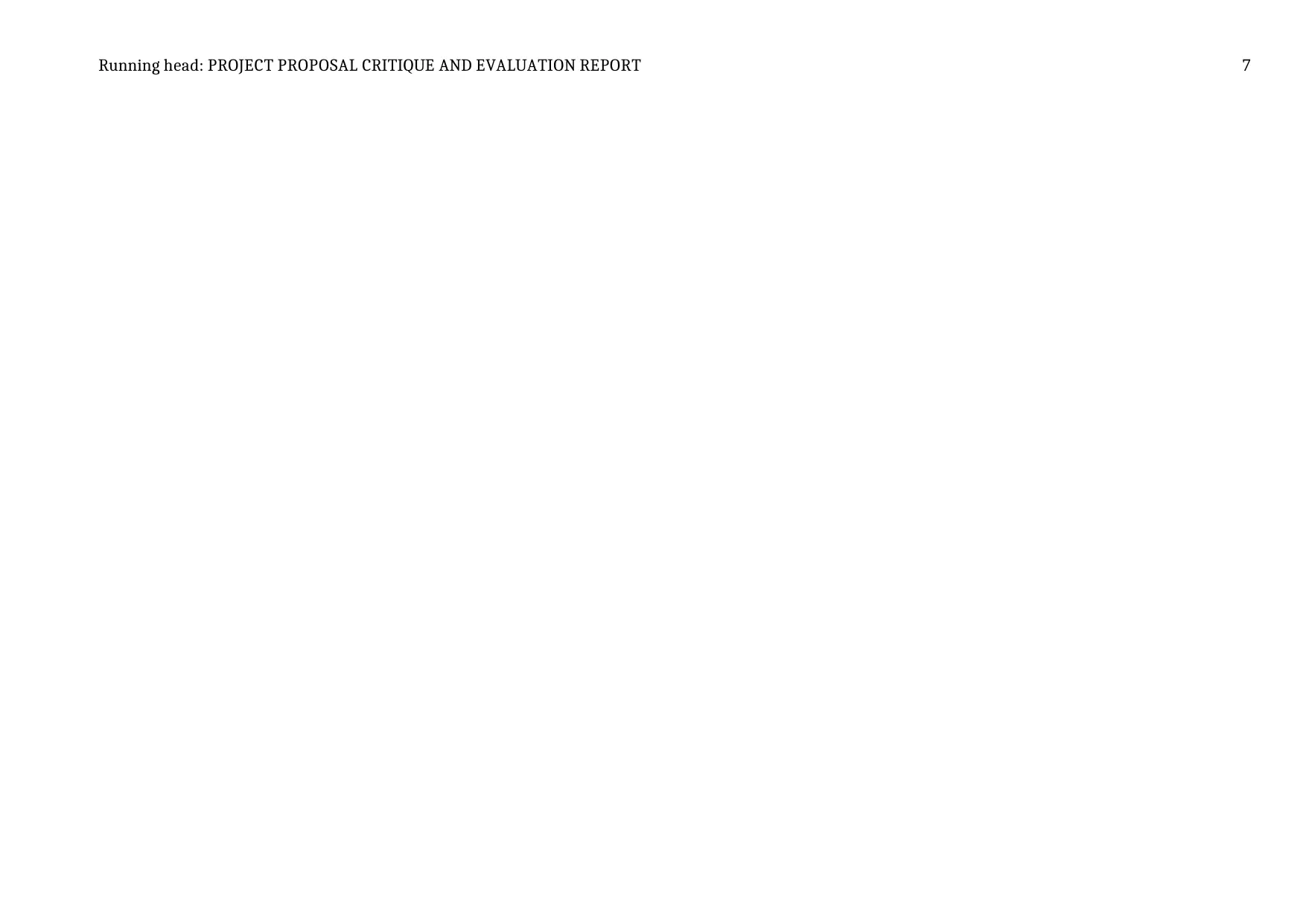
Running head: PROJECT PROPOSAL CRITIQUE AND EVALUATION REPORT 7
Paraphrase This Document
Need a fresh take? Get an instant paraphrase of this document with our AI Paraphraser
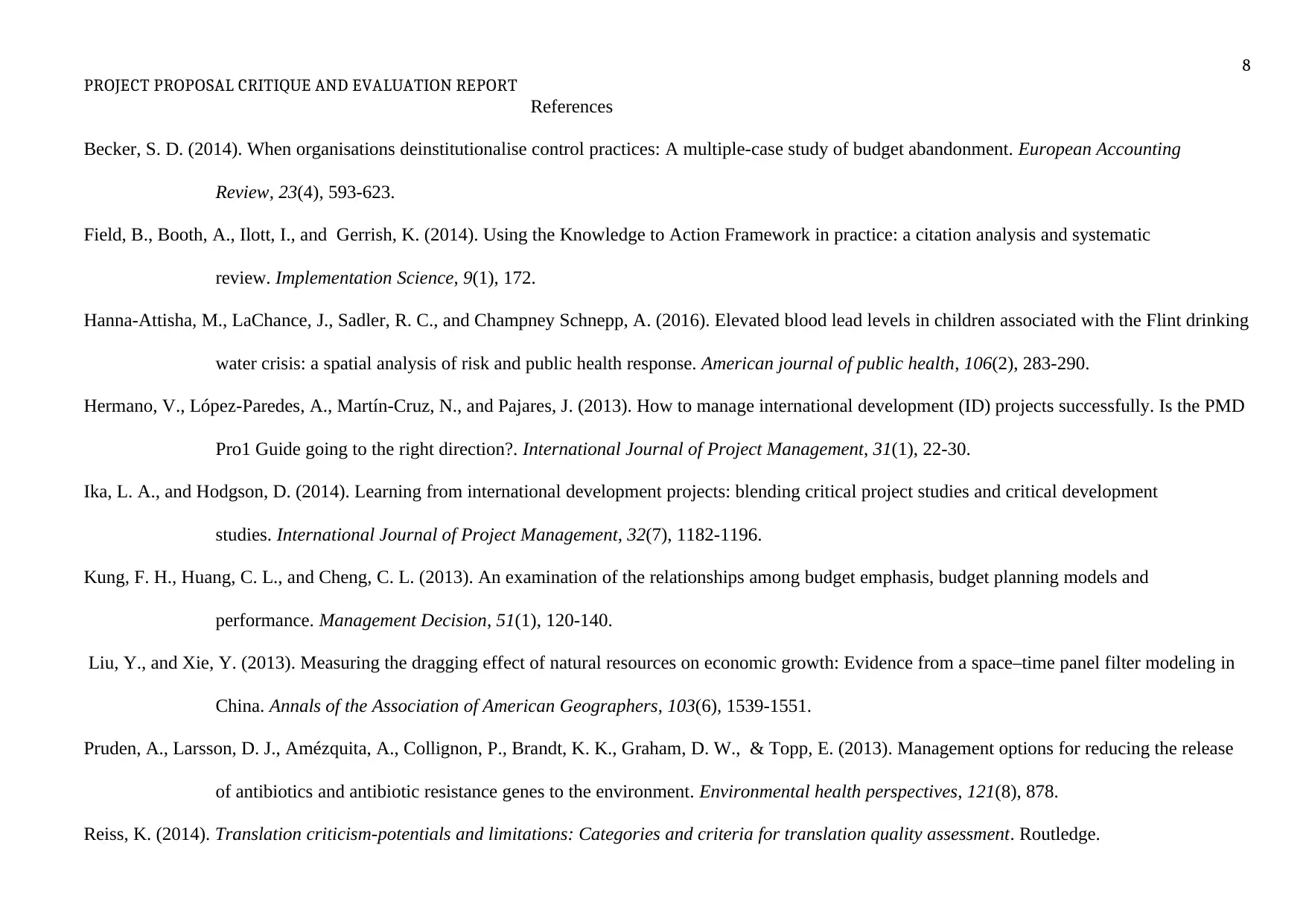
8
PROJECT PROPOSAL CRITIQUE AND EVALUATION REPORT
References
Becker, S. D. (2014). When organisations deinstitutionalise control practices: A multiple-case study of budget abandonment. European Accounting
Review, 23(4), 593-623.
Field, B., Booth, A., Ilott, I., and Gerrish, K. (2014). Using the Knowledge to Action Framework in practice: a citation analysis and systematic
review. Implementation Science, 9(1), 172.
Hanna-Attisha, M., LaChance, J., Sadler, R. C., and Champney Schnepp, A. (2016). Elevated blood lead levels in children associated with the Flint drinking
water crisis: a spatial analysis of risk and public health response. American journal of public health, 106(2), 283-290.
Hermano, V., López-Paredes, A., Martín-Cruz, N., and Pajares, J. (2013). How to manage international development (ID) projects successfully. Is the PMD
Pro1 Guide going to the right direction?. International Journal of Project Management, 31(1), 22-30.
Ika, L. A., and Hodgson, D. (2014). Learning from international development projects: blending critical project studies and critical development
studies. International Journal of Project Management, 32(7), 1182-1196.
Kung, F. H., Huang, C. L., and Cheng, C. L. (2013). An examination of the relationships among budget emphasis, budget planning models and
performance. Management Decision, 51(1), 120-140.
Liu, Y., and Xie, Y. (2013). Measuring the dragging effect of natural resources on economic growth: Evidence from a space–time panel filter modeling in
China. Annals of the Association of American Geographers, 103(6), 1539-1551.
Pruden, A., Larsson, D. J., Amézquita, A., Collignon, P., Brandt, K. K., Graham, D. W., & Topp, E. (2013). Management options for reducing the release
of antibiotics and antibiotic resistance genes to the environment. Environmental health perspectives, 121(8), 878.
Reiss, K. (2014). Translation criticism-potentials and limitations: Categories and criteria for translation quality assessment. Routledge.
PROJECT PROPOSAL CRITIQUE AND EVALUATION REPORT
References
Becker, S. D. (2014). When organisations deinstitutionalise control practices: A multiple-case study of budget abandonment. European Accounting
Review, 23(4), 593-623.
Field, B., Booth, A., Ilott, I., and Gerrish, K. (2014). Using the Knowledge to Action Framework in practice: a citation analysis and systematic
review. Implementation Science, 9(1), 172.
Hanna-Attisha, M., LaChance, J., Sadler, R. C., and Champney Schnepp, A. (2016). Elevated blood lead levels in children associated with the Flint drinking
water crisis: a spatial analysis of risk and public health response. American journal of public health, 106(2), 283-290.
Hermano, V., López-Paredes, A., Martín-Cruz, N., and Pajares, J. (2013). How to manage international development (ID) projects successfully. Is the PMD
Pro1 Guide going to the right direction?. International Journal of Project Management, 31(1), 22-30.
Ika, L. A., and Hodgson, D. (2014). Learning from international development projects: blending critical project studies and critical development
studies. International Journal of Project Management, 32(7), 1182-1196.
Kung, F. H., Huang, C. L., and Cheng, C. L. (2013). An examination of the relationships among budget emphasis, budget planning models and
performance. Management Decision, 51(1), 120-140.
Liu, Y., and Xie, Y. (2013). Measuring the dragging effect of natural resources on economic growth: Evidence from a space–time panel filter modeling in
China. Annals of the Association of American Geographers, 103(6), 1539-1551.
Pruden, A., Larsson, D. J., Amézquita, A., Collignon, P., Brandt, K. K., Graham, D. W., & Topp, E. (2013). Management options for reducing the release
of antibiotics and antibiotic resistance genes to the environment. Environmental health perspectives, 121(8), 878.
Reiss, K. (2014). Translation criticism-potentials and limitations: Categories and criteria for translation quality assessment. Routledge.
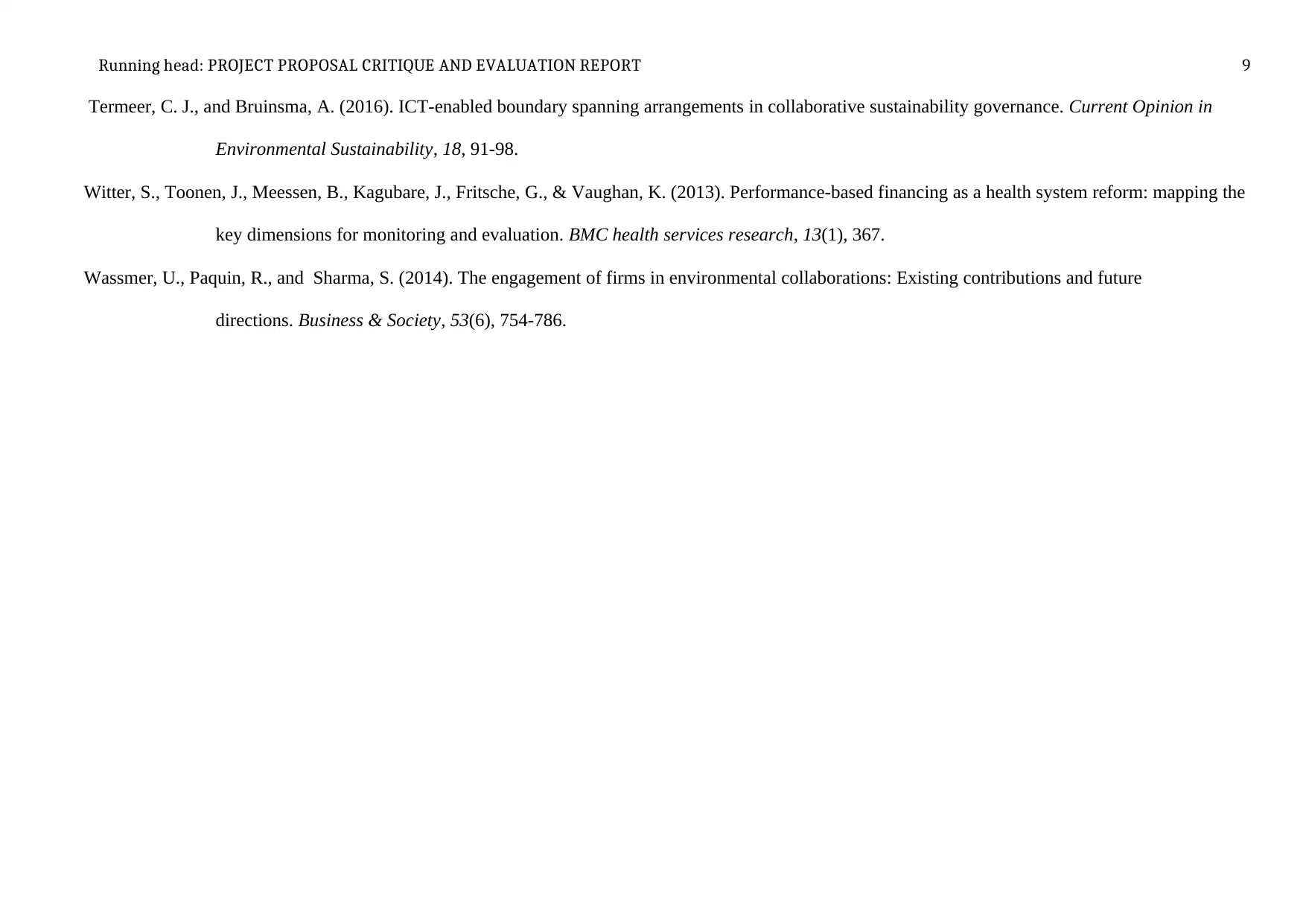
Running head: PROJECT PROPOSAL CRITIQUE AND EVALUATION REPORT 9
Termeer, C. J., and Bruinsma, A. (2016). ICT-enabled boundary spanning arrangements in collaborative sustainability governance. Current Opinion in
Environmental Sustainability, 18, 91-98.
Witter, S., Toonen, J., Meessen, B., Kagubare, J., Fritsche, G., & Vaughan, K. (2013). Performance-based financing as a health system reform: mapping the
key dimensions for monitoring and evaluation. BMC health services research, 13(1), 367.
Wassmer, U., Paquin, R., and Sharma, S. (2014). The engagement of firms in environmental collaborations: Existing contributions and future
directions. Business & Society, 53(6), 754-786.
Termeer, C. J., and Bruinsma, A. (2016). ICT-enabled boundary spanning arrangements in collaborative sustainability governance. Current Opinion in
Environmental Sustainability, 18, 91-98.
Witter, S., Toonen, J., Meessen, B., Kagubare, J., Fritsche, G., & Vaughan, K. (2013). Performance-based financing as a health system reform: mapping the
key dimensions for monitoring and evaluation. BMC health services research, 13(1), 367.
Wassmer, U., Paquin, R., and Sharma, S. (2014). The engagement of firms in environmental collaborations: Existing contributions and future
directions. Business & Society, 53(6), 754-786.
⊘ This is a preview!⊘
Do you want full access?
Subscribe today to unlock all pages.

Trusted by 1+ million students worldwide
1 out of 9
Related Documents
Your All-in-One AI-Powered Toolkit for Academic Success.
+13062052269
info@desklib.com
Available 24*7 on WhatsApp / Email
![[object Object]](/_next/static/media/star-bottom.7253800d.svg)
Unlock your academic potential
Copyright © 2020–2025 A2Z Services. All Rights Reserved. Developed and managed by ZUCOL.



